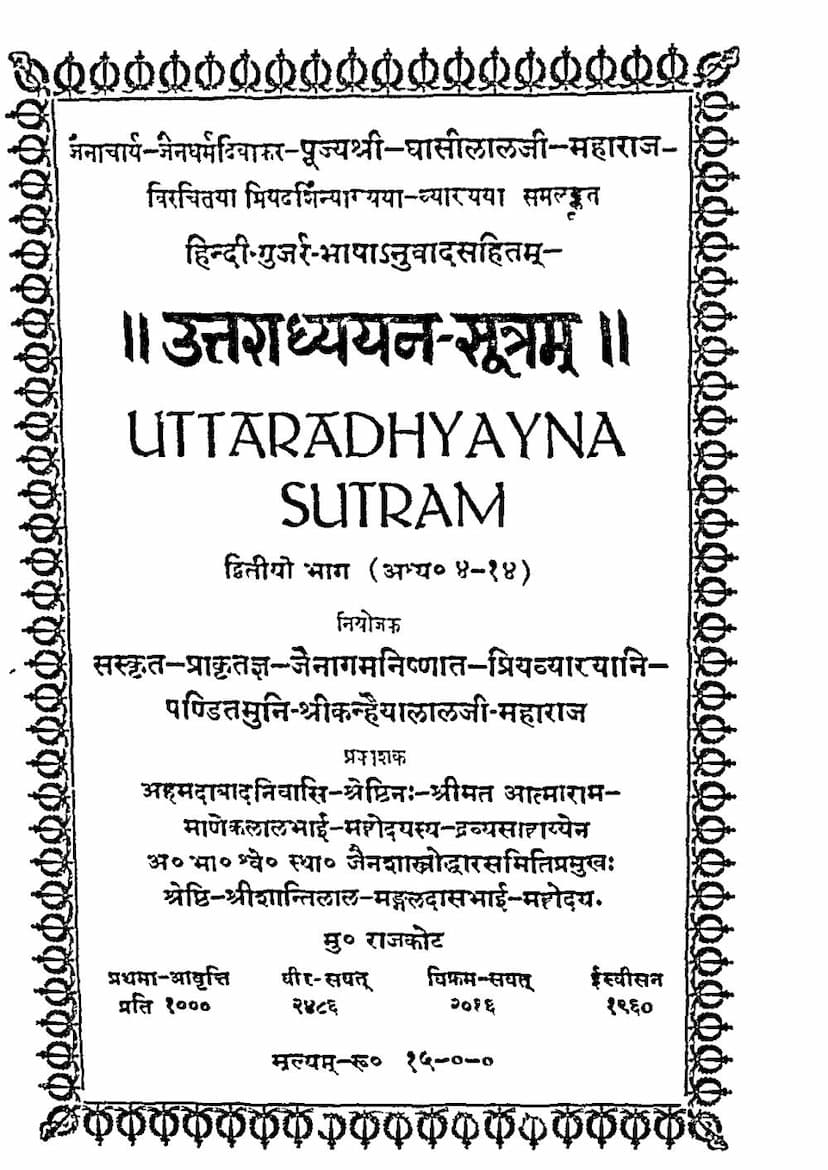Uttaradhyayan Sutram Part 02
Added to library: September 2, 2025

Summary
This comprehensive summary focuses on the "Uttaradhyayan Sutram Part 02," authored by Ghasilal Maharaj and published by A B Shwetambar Sthanakwasi Jain Shastroddhar Samiti. The catalog link provided is https://jainqq.org/explore/009353/1.
The text, in its second part (Chapters 4-14), is a detailed exposition of Jain principles, primarily emphasizing the consequences of actions (karma) and the path to liberation. It uses allegorical narratives and discourses to illustrate these concepts.
Key Themes and Content:
- The Nature of Karma and its Inevitability: The Uttaradhyayan Sutram, particularly the chapters covered in this volume, strongly emphasizes that all actions, whether good or bad, have consequences that must be experienced. The text uses stories of individuals who, despite their actions, are shown to reap the results of their karma. This includes descriptions of individuals going to hell due to their greed and harmful actions.
- The Importance of Renunciation and Detachment: The sutras advocate for detachment from worldly possessions, sensual pleasures, and even familial bonds, as these are seen as sources of suffering and impediments to spiritual progress. The narratives often highlight the spiritual benefits and liberation that come from renouncing the mundane.
- The Teachings on Moral Conduct and Discipline: The text provides guidance on virtuous living, emphasizing self-discipline, control over senses, and adherence to Jain ethical principles. It details the importance of right faith, right knowledge, and right conduct (the Three Jewels of Jainism) as the path to spiritual emancipation.
- The Consequences of Indulgence and Negligence: Chapters often begin by referencing previous teachings and then delve into the dangers of negligence (pramada) in spiritual practices. The stories illustrate how attachment to worldly things and indulgence in vices lead to suffering and rebirth in lower realms.
- Illustrative Narratives (Vyakhyanas/Drishtantas): The sutra is rich with stories that serve as didactic examples. These stories feature various characters, including kings, thieves, merchants, and ascetics, whose lives are used to demonstrate specific virtues or vices and their karmic outcomes. For instance, the Anamall wrestler, Durvritta chor (thief), Durnati chor, Kapila Muni, Nami Raja, and Ashvadrishtanta are mentioned as key figures whose life stories are used for teaching.
- The Supremacy of Dharma: Throughout the text, "Dharma" (righteousness, spiritual duty) is presented as the ultimate refuge and the only true support in all circumstances, especially in old age and during times of distress. It is presented as the only path to liberation from the cycle of birth and death.
- The Role of the Guru: The text implicitly and explicitly highlights the crucial role of a spiritual guide (Guru) in leading the disciple towards liberation. The Guru's teachings and discipline are presented as essential for understanding and practicing the Dharma.
- The Cycles of Life and Rebirth: The underlying philosophy is the Jain belief in the transmigration of the soul and the cycle of rebirth, driven by karma. The stories often depict the soul's journey through various lifespans and the karmic consequences that shape these experiences.
- Specific Chapters Covered: The volume specifically covers chapters 4 through 14, which are indicated in the "Uttaradhyayan Sutram Dwitiyo Bhag (Abhy. 4-14)" on page 3. The table of contents (on page 7) provides a detailed list of the subjects within these chapters, including:
- Chapter 4: The helplessness of the aged and the absence of refuge.
- Chapters 5-8: Illustrative examples of the consequences of wealth, greed, and actions.
- Chapters 9-12: The impact of wealth and the importance of right conduct.
- Chapters 13-14: The importance of not being negligent and renouncing it.
- And subsequent chapters covering various aspects of spiritual discipline, renunciation, and the path to liberation, often illustrated through the lives of saints and sages.
Editorial and Publishing Details:
- Author: Ghasilal Maharaj (विरचितया प्रियदर्शिनी - This indicates the work is attributed to him and is annotated or explained by him.)
- Commentary: Hindi-Gujarati translation and commentary by Muni Shri Kanhiyalalji Maharaj (हिन्दी · गुजर्र-भाषाऽनुवादसहितम्... प्रियव्यारयानिपण्डित मुनि श्री कन्हैयालालजी महाराज).
- Publisher: A B Shwetambar Sthanakwasi Jain Shastroddhar Samiti, Ahmedabad (अ० भा० ४वे० स्था० जैन शस्तरोद्धार समिति).
- Sponsor: Shrimat Atmaram Maneklal Mahoday's financial assistance (श्रेष्ठिनः श्रीमत आत्माराम माणिकलालभाई - महोदयस्य - द्रव्यसाहाय्येन).
- First Edition: 1960 AD (ईस्वीसन १९६०) / Vikram Samvat 2016 / Vir Samvat 2486.
- Price: Rs. 15-0-0.
- Number of Copies Printed: 1000.
Biographical Information:
The text also includes a detailed biography of Seth Atmaram Maneklal on pages 5 and 6, highlighting his devout nature, regular religious observances, charitable acts, encouragement of Jain literature, and his overall dedication to the Jain faith. He passed away at the age of 84 in Samvat 2015, showing remarkable devotion until his last days.
In essence, this part of the Uttaradhyayan Sutram is a philosophical and ethical guide, using illustrative stories and teachings to illuminate the Jain path of righteousness, renunciation, and ultimately, liberation, emphasizing the eternal principle of karma.